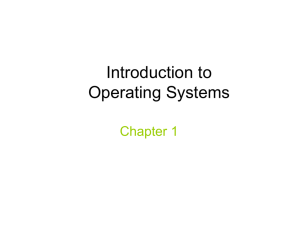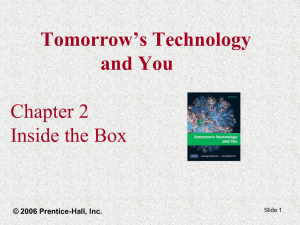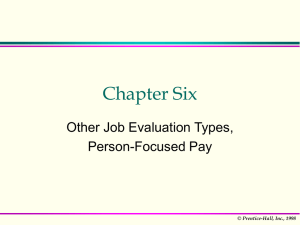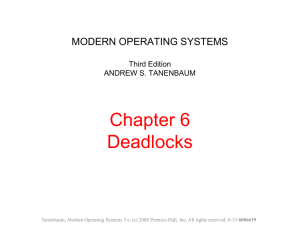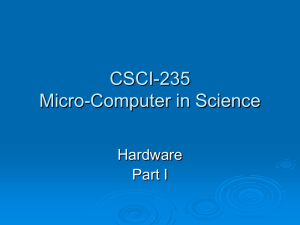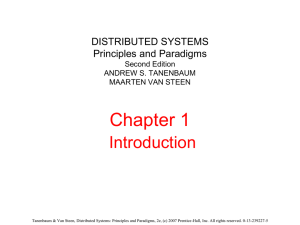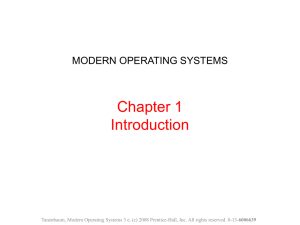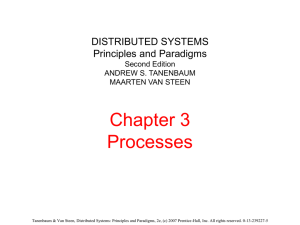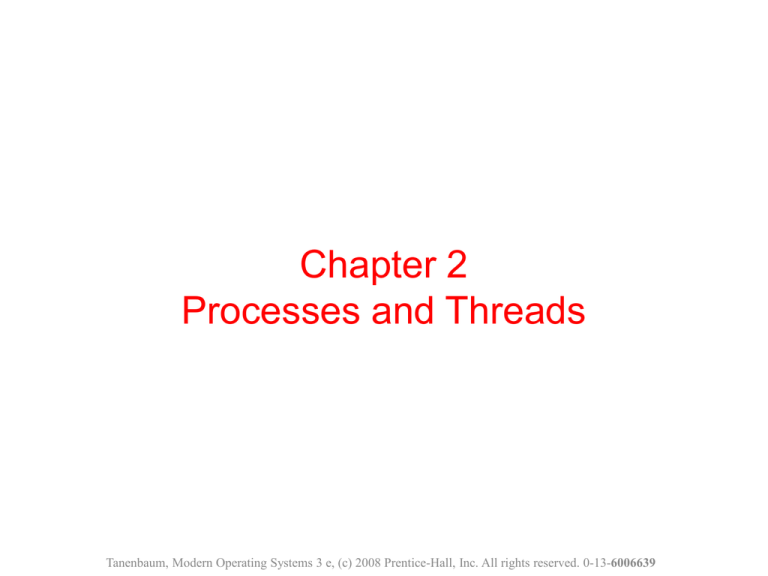
Chapter 2
Processes and Threads
Tanenbaum, Modern Operating Systems 3 e, (c) 2008 Prentice-Hall, Inc. All rights reserved. 0-13-6006639
What is a process?
•
An instance of a program, replete with registers,
variables, and a program counter
It has a program, input, output and a state
Why is this idea necessary?
•
•
•
A computer manages many computations concurrently-need
an abstraction to describe how it does it
Tanenbaum, Modern Operating Systems 3 e, (c) 2008 Prentice-Hall, Inc. All rights reserved. 0-13-6006639
Multiprogramming
(a) Multiprogramming of four programs. (b) Conceptual model of
four independent, sequential processes. (c) Only one
program is active at once.
Tanenbaum, Modern Operating Systems 3 e, (c) 2008 Prentice-Hall, Inc. All rights reserved. 0-13-6006639
Process Creation
Events which can cause process creation
•
•
•
•
System initialization.
Execution of a process creation system call by a
running process.
A user request to create a new process.
Initiation of a batch job.
Tanenbaum, Modern Operating Systems 3 e, (c) 2008 Prentice-Hall, Inc. All rights reserved. 0-13-6006639
Process Termination
Events which cause process termination:
•
•
•
•
Normal exit (voluntary).
Error exit (voluntary).
Fatal error (involuntary).
Killed by another process (involuntary).
Tanenbaum, Modern Operating Systems 3 e, (c) 2008 Prentice-Hall, Inc. All rights reserved. 0-13-6006639
Process States
A process can be in running, blocked, or ready state. Transitions
between these states are as shown.
Tanenbaum, Modern Operating Systems 3 e, (c) 2008 Prentice-Hall, Inc. All rights reserved. 0-13-6006639
Implementation of Processes (1)
The lowest layer of a process-structured operating system
handles interrupts and scheduling. Above that layer are
sequential processes.
Tanenbaum, Modern Operating Systems 3 e, (c) 2008 Prentice-Hall, Inc. All rights reserved. 0-13-6006639
Implementation of Processes (2)
Some of the fields of a typical process table entry.
Tanenbaum, Modern Operating Systems 3 e, (c) 2008 Prentice-Hall, Inc. All rights reserved. 0-13-6006639
OS processes an interrupt
Skeleton of what the lowest level of the operating system does
when an interrupt occurs.
Tanenbaum, Modern Operating Systems 3 e, (c) 2008 Prentice-Hall, Inc. All rights reserved. 0-13-6006639
How multiprogramming performs
CPU utilization as a function of the number of processes in
memory.
Tanenbaum, Modern Operating Systems 3 e, (c) 2008 Prentice-Hall, Inc. All rights reserved. 0-13-6006639
Thread Example-web server
.
.
Tanenbaum, Modern Operating Systems 3 e, (c) 2008 Prentice-Hall, Inc. All rights reserved. 0-13-6006639
Web server code
(a) Dispatcher thread. (b) Worker thread.
Tanenbaum, Modern Operating Systems 3 e, (c) 2008 Prentice-Hall, Inc. All rights reserved. 0-13-6006639
Web server
•
•
•
If page is not there, then thread blocks
CPU does nothing while it waits for page
Thread structure enables server to instantiate another
page and get something done
Tanenbaum, Modern Operating Systems 3 e, (c) 2008 Prentice-Hall, Inc. All rights reserved. 0-13-6006639
Another way to do the same thing-finite
state machine
•
•
•
If page is not there, use a non-blocking call
When thread returns page send interrupt to CPU,
(signal)
Causes process context switch (expensive)
Tanenbaum, Modern Operating Systems 3 e, (c) 2008 Prentice-Hall, Inc. All rights reserved. 0-13-6006639
Three ways to build the server
Tanenbaum, Modern Operating Systems 3 e, (c) 2008 Prentice-Hall, Inc. All rights reserved. 0-13-6006639
Reasons to use threads
•
•
•
•
Enables parallelism (web server) with blocking system
calls
Threads are faster to create and destroy then
processes
Natural for multiple cores
Easy programming model
Tanenbaum, Modern Operating Systems 3 e, (c) 2008 Prentice-Hall, Inc. All rights reserved. 0-13-6006639
Threads are lightweight
Tanenbaum, Modern Operating Systems 3 e, (c) 2008 Prentice-Hall, Inc. All rights reserved. 0-13-6006639
Threads are like processes
•
•
•
Have same states
•
Running
•
Ready
•
Blocked
Have their own stacks –same as processes
Stacks contain frames for (un-returned) procedure calls
•
Local variables
•
Return address to use when procedure comes back
Tanenbaum, Modern Operating Systems 3 e, (c) 2008 Prentice-Hall, Inc. All rights reserved. 0-13-6006639
How do threads work?
•
•
•
Start with one thread in a process
Thread contains (id, registers, attributes)
Use library call to create new threads and
to use threads
•
•
•
•
Thread_create includes parameter indicating what procedure
to run
Thread_exit causes thread to exit and disappear (can’t
schedule it)
Thread_join Thread blocks until another thread finishes its
work
Thread_yield
POSIX Threads (Pthreads)
Pthreads are IEEE Unix standard library calls
Tanenbaum, Modern Operating Systems 3 e, (c) 2008 Prentice-Hall, Inc. All rights reserved. 0-13-6006639
A Pthreads example-”Hello,world”
...
.
Tanenbaum, Modern Operating Systems 3 e, (c) 2008 Prentice-Hall, Inc. All rights reserved. 0-13-6006639
Implementing Threads in User Space
(a) A user-level threads package. (b) A threads package managed
by the kernel.
Tanenbaum, Modern Operating Systems 3 e, (c) 2008 Prentice-Hall, Inc. All rights reserved. 0-13-6006639
Threads in user space-the good
•
•
•
Thread table contains info about threads (program
counter, stack pointer...) so that run time system can
manage them
If thread blocks, run time system stores thread info in
table and finds new thread to run.
State save and scheduling are invoked faster then
kernel call (no trap, no cache flush)
Tanenbaum, Modern Operating Systems 3 e, (c) 2008 Prentice-Hall, Inc. All rights reserved. 0-13-6006639
Threads in user space-the bad
•
•
•
Can’t let thread execute system call which blocks
because it will block all of the other threads
No elegant solution
•
Hack system library to avoid blocking calls
•
Could use select system calls-in some versions of
Unix which do same thing
Threads don’t voluntarily give up CPU
•
Could interrupt periodically to give control to run
time system
•
Overhead of this solution is a problem…..
Tanenbaum, Modern Operating Systems 3 e, (c) 2008 Prentice-Hall, Inc. All rights reserved. 0-13-6006639
Threads in kernel space-the good
•
•
•
Kernel keeps same thread table as user table
If thread blocks, kernel just picks another one
Not necessarily from same process!
The bad-expensive to manage the threads in the
kernel and takes valuable kernel space
Tanenbaum, Modern Operating Systems 3 e, (c) 2008 Prentice-Hall, Inc. All rights reserved. 0-13-6006639
Threads in kernel space-the bad
•
•
Expensive to manage the threads in the kernel and
takes valuable kernel space
How do we get the advantages of both approaches,
without the disadvantages?
Tanenbaum, Modern Operating Systems 3 e, (c) 2008 Prentice-Hall, Inc. All rights reserved. 0-13-6006639
Hybrid approach
Multiplex user-level threads onto kernel level threads
Tanenbaum, Modern Operating Systems 3 e, (c) 2008 Prentice-Hall, Inc. All rights reserved. 0-13-6006639
Hybrid
•
•
•
Kernel is aware of kernel threads only
User level threads are scheduled, created destroyed
independently of kernel thread
Programmer determines how many user level and
how many kernel level threads to use
Tanenbaum, Modern Operating Systems 3 e, (c) 2008 Prentice-Hall, Inc. All rights reserved. 0-13-6006639
Scheduler activations-Upcalls
•
Want the run time system to switch threads when a
thread blocks
•
•
•
Associate a virtual processor with each process
Run time system allocates threads to virtual processors
Kernel notifies the run time system that
•
•
•
a thread has blocked
passes info to RTS (thread id…)
RTS schedules another thread
Tanenbaum, Modern Operating Systems 3 e, (c) 2008 Prentice-Hall, Inc. All rights reserved. 0-13-6006639
Pop-Up Threads
(How to handle message arrivals in distributed systems)
Create a new thread when a message arrives
Tanenbaum, Modern Operating Systems 3 e, (c) 2008 Prentice-Hall, Inc. All rights reserved. 0-13-6006639
Why pop ups?
•
•
•
•
Could use thread which blocks on a receive
system call and processes messages when
they arrive
Means that you have to restore the history of
the thread each time a message arrives
Pop ups are entirely new-nothing to restore
They are faster
Tanenbaum, Modern Operating Systems 3 e, (c) 2008 Prentice-Hall, Inc. All rights reserved. 0-13-6006639
Adding threads to an OS-problems
•
•
•
How do we implement variables which should be
global to a thread but not to the entire program?
Example: Thread wants access to a file, Unix grants
access via global errno
Race ensues-thread 1 can get the wrong permission
because thread 2 over-writes it
Tanenbaum, Modern Operating Systems 3 e, (c) 2008 Prentice-Hall, Inc. All rights reserved. 0-13-6006639
Thread 1 gets the wrong permission
Tanenbaum, Modern Operating Systems 3 e, (c) 2008 Prentice-Hall, Inc. All rights reserved. 0-13-6006639
Solution-Create private global variables
Tanenbaum, Modern Operating Systems 3 e, (c) 2008 Prentice-Hall, Inc. All rights reserved. 0-13-6006639
How?
•
•
Could use library routines to create, set and read
globals.
Global is then unique to each thread
Tanenbaum, Modern Operating Systems 3 e, (c) 2008 Prentice-Hall, Inc. All rights reserved. 0-13-6006639
More problems
•
Library routine which is not re-entrant.
•
•
Eg. Sending a message-one thread puts message in a
buffer, new thread appears and over-writes message
Memory allocation programs may be (temporarily) in
an inconsistent state
•
•
Eg. New thread gets wrong pointer
Hard do we implement signals which are thread
specific ?
•
If threads are in user space, kernel can’t address right
thread.
Tanenbaum, Modern Operating Systems 3 e, (c) 2008 Prentice-Hall, Inc. All rights reserved. 0-13-6006639
MORAL OF THE STORY
Need to re-work the semantics of system
calls and library routines in order to add
threads to a system
Interprocess Communication
•
Three problems
•
•
•
•
How to actually do it
How to deal with process conflicts (2 airline
reservations for same seat)
•
How to do correct sequencing when dependencies are
present-aim the gun before firing it
SAME ISSUES FOR THREADS AS FOR PROCESSES-SAME
SOLUTIONS AS WELL
Proceed to discuss these problems
.
Tanenbaum, Modern Operating Systems 3 e, (c) 2008 Prentice-Hall, Inc. All rights reserved. 0-13-6006639
Race Conditions
In is local variable containing pointer to next free slot
Out is local variable pointing to next file to be printed
Tanenbaum, Modern Operating Systems 3 e, (c) 2008 Prentice-Hall, Inc. All rights reserved. 0-13-6006639
How to avoid races
•
•
•
Mutual exclusion–only one process at a time can use
a shared variable/file
Critical regions-shared memory which leads to races
Solution- Ensure that two processes can’t be in the
critical region at the same time
.
Tanenbaum, Modern Operating Systems 3 e, (c) 2008 Prentice-Hall, Inc. All rights reserved. 0-13-6006639
Properties of a good solution
•
•
•
•
Mutual exclusion
No assumptions about speeds or number of CPU’s
No process outside critical region can block other
processes
No starvation-no process waits forever to enter
critical region
.
Tanenbaum, Modern Operating Systems 3 e, (c) 2008 Prentice-Hall, Inc. All rights reserved. 0-13-6006639
What we are trying to do
Tanenbaum, Modern Operating Systems 3 e, (c) 2008 Prentice-Hall, Inc. All rights reserved. 0-13-6006639
First attempts-Busy Waiting
A laundry list of proposals to achieve mutual
exclusion
•
•
•
•
•
Disabling interrupts
Lock variables
Strict alternation
Peterson's solution
The TSL instruction
Tanenbaum, Modern Operating Systems 3 e, (c) 2008 Prentice-Hall, Inc. All rights reserved. 0-13-6006639
Disabling Interrupts
•
•
Idea: process disables interrupts, enters cr,
enables interrupts when it leaves cr
Problems
•
Process might never enable interrupts,
crashing system
•
Won’t work on multi-core chips as disabling
interrupts only effects one CPU at a time
Tanenbaum, Modern Operating Systems 3 e, (c) 2008 Prentice-Hall, Inc. All rights reserved. 0-13-6006639
Lock variables
•
•
A software solution-everyone shares a lock
•
When lock is 0, process turns it to 1 and
enters cr
•
When exit cr, turn lock to 0
Problem-Race condition
Tanenbaum, Modern Operating Systems 3 e, (c) 2008 Prentice-Hall, Inc. All rights reserved. 0-13-6006639
Strict Alternation
First me, then
you
Tanenbaum, Modern Operating Systems 3 e, (c) 2008 Prentice-Hall, Inc. All rights reserved. 0-13-6006639
Problems with strict alternation
•
•
Employs busy waiting-while waiting for the cr, a
process spins
If one process is outside the cr and it is its turn,
then other process has to wait until outside guy
finishes both outside AND inside (cr) work
Tanenbaum, Modern Operating Systems 3 e, (c) 2008 Prentice-Hall, Inc. All rights reserved. 0-13-6006639
Peterson's Solution
.
Tanenbaum, Modern Operating Systems 3 e, (c) 2008 Prentice-Hall, Inc. All rights reserved. 0-13-6006639
Peterson
•
•
•
Process 0 & 1 try to get in simultaneously
Last one in sets turn: say it is process 1
Process 0 enters (turn= = process is False)
Tanenbaum, Modern Operating Systems 3 e, (c) 2008 Prentice-Hall, Inc. All rights reserved. 0-13-6006639
TSL
•
•
TSL reads lock into register and stores NON
ZERO VALUE in lock (e.g. process number)
Instruction is atomic: done by freezing access to
bus line (bus disable)
Tanenbaum, Modern Operating Systems 3 e, (c) 2008 Prentice-Hall, Inc. All rights reserved. 0-13-6006639
Using TSL
TSL is atomic. Memory bus is locked until it is finished executing.
Tanenbaum, Modern Operating Systems 3 e, (c) 2008 Prentice-Hall, Inc. All rights reserved. 0-13-6006639
XCHG instruction
Xchg a,b exchanges a & b
Tanenbaum, Modern Operating Systems 3 e, (c) 2008 Prentice-Hall, Inc. All rights reserved. 0-13-6006639
What’s wrong with Peterson, TSL ,XCHG?
•
•
Busy waiting-waste of CPU time!
Idea: Replace busy waiting by blocking calls
•
Sleep blocks process
•
Wakeup unblocks process
Tanenbaum, Modern Operating Systems 3 e, (c) 2008 Prentice-Hall, Inc. All rights reserved. 0-13-6006639
The Producer-Consumer Problem (aka
Bounded Buffer Problem)
...
Tanenbaum, Modern Operating Systems 3 e, (c) 2008 Prentice-Hall, Inc. All rights reserved. 0-13-6006639
The problem with sleep and wake-up calls
•
•
•
•
•
•
•
Empty buffer,count==0
Consumer gets replaced by producer before it
goes to sleep
Produces something, count++, sends wakeup to
consumer
Consumer not asleep, ignores wakeup, thinks
count= = 0, goes to sleep
Producer fills buffer, goes to sleep
P and C sleep forever
So the problem is lost wake-up calls
Tanenbaum, Modern Operating Systems 3 e, (c) 2008 Prentice-Hall, Inc. All rights reserved. 0-13-6006639
P kisses C, who becomes a prince. All is
well.
Semaphores
•
•
•
•
•
•
Semaphore is an integer variable
Used to sleeping processes/wakeups
Two operations, down and up
Down checks semaphore. If not zero,
decrements semaphore. If zero, process goes to
sleep
Up increments semaphore. If more then one
process asleep, one is chosen randomly and
enters critical region (first does a down)
ATOMIC IMPLEMENTATION-interrupts disabled
Tanenbaum, Modern Operating Systems 3 e, (c) 2008 Prentice-Hall, Inc. All rights reserved. 0-13-6006639
Producer Consumer with Semaphores
•
•
•
•
3 semaphores: full, empty and mutex
Full counts full slots (initially 0)
Empty counts empty slots (initially N)
Mutex protects variable which contains the items
produced and consumed
Tanenbaum, Modern Operating Systems 3 e, (c) 2008 Prentice-Hall, Inc. All rights reserved. 0-13-6006639
Producer Consumer with semaphores
...
Tanenbaum, Modern Operating Systems 3 e, (c) 2008 Prentice-Hall, Inc. All rights reserved. 0-13-6006639
Mutexes
•
Don’t always need counting operation of
semaphore, just mutual exclusion part
Mutex: variable which can be in one of two
states-locked (0), unlocked(1 or other value)
•
•
•
Easy to implement
Good for using with thread packages in user
space
•
•
Thread (process) wants access to cr, calls mutex_lock.
If mutex is unlocked, call succeeds. Otherwise, thread
blocks until thread in the cr does a mutex_unlock.
Tanenbaum, Modern Operating Systems 3 e, (c) 2008 Prentice-Hall, Inc. All rights reserved. 0-13-6006639
Mutexes
User space code for mutex lock and unlock
Tanenbaum, Modern Operating Systems 3 e, (c) 2008 Prentice-Hall, Inc. All rights reserved. 0-13-6006639
More Mutex
•
•
•
Enter region code for TSL results in busy waiting
(process keeps testing lock)
•
Clock runs out, process is bumped from CPU
No clock for threads => spinning thread could
wait forever =>need to get spinner out of there
Use thread_yield to give up the CPU to another
thread.
•
Thread yield is fast (in user space).
•
No kernel calls needed for mutex_lock or
mutex_unlock.
Tanenbaum, Modern Operating Systems 3 e, (c) 2008 Prentice-Hall, Inc. All rights reserved. 0-13-6006639
Pthread calls for mutexes
Pthread_mutex-trylock tries to lock mutex. If it fails it returns an
error code, and can do something else.
Tanenbaum, Modern Operating Systems 3 e, (c) 2008 Prentice-Hall, Inc. All rights reserved. 0-13-6006639
Condition Variables
•
•
•
•
Allows a thread to block if a condition is not met,
e.g. Producer-Consumer. Producer needs to
block if the buffer is full.
Mutex make it possible to check if buffer is full
Condition variable makes it possible to put
producer to sleep if buffer is full
Both are present in pthreads and are used
together
Tanenbaum, Modern Operating Systems 3 e, (c) 2008 Prentice-Hall, Inc. All rights reserved. 0-13-6006639
Pthread Condition Variable calls
Tanenbaum, Modern Operating Systems 3 e, (c) 2008 Prentice-Hall, Inc. All rights reserved. 0-13-6006639
Producer Consumer with condition variables
and mutexes
•
•
•
•
Producer produces one item and blocks waiting
for consumer to use the item
Signals consumer that the item has been
produced
Consumer blocks waiting for producer to signal
that item is in buffer
Consumer consumes item, signals producer to
produce new item
Tanenbaum, Modern Operating Systems 3 e, (c) 2008 Prentice-Hall, Inc. All rights reserved. 0-13-6006639
Producer Consumer with condition variables
...
.
Tanenbaum, Modern Operating Systems 3 e, (c) 2008 Prentice-Hall, Inc. All rights reserved. 0-13-6006639
Monitors
•
•
•
Easy to make a mess of things using mutexes
and condition variables. Little errors cause
disasters.
•
Producer consumer with semaphoresinterchange two downs in producer code
causes deadlock
Monitor is a language construct which enforces
mutual exclusion and blocking mechanism
C does not have monitor
Tanenbaum, Modern Operating Systems 3 e, (c) 2008 Prentice-Hall, Inc. All rights reserved. 0-13-6006639
Monitors
•
•
•
Monitor consists of {procedures, data structures,
and variables} grouped together in a “module”
A process can call procedures inside the monitor,
but cannot directly access the stuff inside the
monitor
C does not have monitors
Tanenbaum, Modern Operating Systems 3 e, (c) 2008 Prentice-Hall, Inc. All rights reserved. 0-13-6006639
Monitor-a picture
Tanenbaum, Modern Operating Systems 3 e, (c) 2008 Prentice-Hall, Inc. All rights reserved. 0-13-6006639
Onwards
•
•
In a monitor it is the job of the compiler, not the
programmer to enforce mutual exclusion.
Only one process at a time can be in the monitor
When a process calls a monitor, the first thing done is
to check if another process is in the monitor. If so,
calling process is suspended.
•
Need to enforce blocking as well –
•
use condition variables
•
Use wait , signal ops on cv’s
Tanenbaum, Modern Operating Systems 3 e, (c) 2008 Prentice-Hall, Inc. All rights reserved. 0-13-6006639
Condition Variables
•
•
•
Monitor discovers that it can’t continue (e.g.
buffer is full), issues a signal on a condition
variable (e.g. full) causing process (e.g.
producer) to block
Another process is allowed to enter the monitor
(e.g. consumer).This process can can issue a
signal, causing blocked process (producer) to
wake up
Process issuing signal leaves monitor
Tanenbaum, Modern Operating Systems 3 e, (c) 2008 Prentice-Hall, Inc. All rights reserved. 0-13-6006639
Producer Consumer Monitor
Tanenbaum, Modern Operating Systems 3 e, (c) 2008 Prentice-Hall, Inc. All rights reserved. 0-13-6006639
Monitors:Good vs Bad
•
•
•
The good-No messy direct programmer control of
semaphores
The bad- You need a language which supports
monitors (Java).
OS’s are written in C
Tanenbaum, Modern Operating Systems 3 e, (c) 2008 Prentice-Hall, Inc. All rights reserved. 0-13-6006639
Semaphores:Good vs Bad
•
•
The good-Easy to implement
The bad- Easy to mess up
Tanenbaum, Modern Operating Systems 3 e, (c) 2008 Prentice-Hall, Inc. All rights reserved. 0-13-6006639
Reality
•
•
Monitors and semaphores only work for shared
memory
Don’t work for multiple CPU’s which have their
own private memory, e.g. workstations on an
Ethernet
Tanenbaum, Modern Operating Systems 3 e, (c) 2008 Prentice-Hall, Inc. All rights reserved. 0-13-6006639
Message Passing
•
•
•
Information exchange between machines
Two primitives
•
Send(destination, &message)
•
Receive(source,&message)
Lots of design issues
•
•
Message loss
•
acknowledgements, time outs deal with loss
Authentication-how does a process know the identity of
the sender? For sure, that is
Tanenbaum, Modern Operating Systems 3 e, (c) 2008 Prentice-Hall, Inc. All rights reserved. 0-13-6006639
Producer Consumer Using Message
Passing
•
•
Consumer sends N empty messages to producer
Producer fills message with data and sends to
consumer
Tanenbaum, Modern Operating Systems 3 e, (c) 2008 Prentice-Hall, Inc. All rights reserved. 0-13-6006639
Producer-Consumer Problem
with Message Passing (1)
...
.
Tanenbaum, Modern Operating Systems 3 e, (c) 2008 Prentice-Hall, Inc. All rights reserved. 0-13-6006639
Producer-Consumer Problem
with Message Passing (2)
...
Tanenbaum, Modern Operating Systems 3 e, (c) 2008 Prentice-Hall, Inc. All rights reserved. 0-13-6006639
Message Passing Approaches
•
•
Have unique ID for address of recipient process
Mailbox
•
•
•
In producer consumer, have one for the producer and
one for the consumer
No buffering-sending process blocks until the
receive happens. Receiver blocks until send
occurs (Rendezvous)
MPI
Tanenbaum, Modern Operating Systems 3 e, (c) 2008 Prentice-Hall, Inc. All rights reserved. 0-13-6006639
Barriers
. Barriers are intended for synchronizing groups of processes
Often used in scientific computations.
Tanenbaum, Modern Operating Systems 3 e, (c) 2008 Prentice-Hall, Inc. All rights reserved. 0-13-6006639
Who cares about scheduling algorithms?
•
•
•
•
Batch servers
Time sharing machines
Networked servers
You care if you have a bunch of users
and/or if the demands of the jobs differ
Tanenbaum, Modern Operating Systems 3 e, (c) 2008 Prentice-Hall, Inc. All rights reserved. 0-13-6006639
Who doesn’t care about scheduling
algorithms?
•
PC’s
•
One user who only competes with himself for the
CPU
Tanenbaum, Modern Operating Systems 3 e, (c) 2008 Prentice-Hall, Inc. All rights reserved. 0-13-6006639
Scheduling – Process Behavior
Bursts of CPU usage alternate with periods of waiting for I/O. (a) A
CPU-bound process. (b) An I/O-bound process.
Tanenbaum, Modern Operating Systems 3 e, (c) 2008 Prentice-Hall, Inc. All rights reserved. 0-13-6006639
When to make scheduling decisions
•
New process creation (run parent or
child)
• Schedule when
• A process exits
• A process blocks (e.g. on a
semaphore)
• I/O interrupt happens
Tanenbaum, Modern Operating Systems 3 e, (c) 2008 Prentice-Hall, Inc. All rights reserved. 0-13-6006639
Categories of Scheduling Algorithms
•
•
•
•
Batch (accounts receivable, payroll…..)
Interactive
Real time (deadlines)
Depends on the use to which the CPU is
being put
Tanenbaum, Modern Operating Systems 3 e, (c) 2008 Prentice-Hall, Inc. All rights reserved. 0-13-6006639
Scheduling Algorithm Goals
Tanenbaum, Modern Operating Systems 3 e, (c) 2008 Prentice-Hall, Inc. All rights reserved. 0-13-6006639
Scheduling in Batch Systems
•
•
•
First-come first-served
Shortest job first
Shortest remaining time next
Tanenbaum, Modern Operating Systems 3 e, (c) 2008 Prentice-Hall, Inc. All rights reserved. 0-13-6006639
First come first serve
•
•
Easy to implement
Won’t work for a varied workload
•
I/O process (long execution time) runs in
front of interactive process (short execution
time)
Tanenbaum, Modern Operating Systems 3 e, (c) 2008 Prentice-Hall, Inc. All rights reserved. 0-13-6006639
Shortest Job First
•
•
•
Need to know run times in
advance
Non pre-emptive algorithm
Provably optimal
Eg 4 jobs with runs times of a,b,c,d
First finishes at a, second at a+b,third at a+b+c,
last at a+b+c+d
=>
Mean turnaround time is (4a+3b+2c+d)/4
smallest time has to come first to minimize the
mean turnaround time
Tanenbaum, Modern Operating Systems 3 e, (c) 2008 Prentice-Hall, Inc. All rights reserved. 0-13-6006639
Shortest Running Time Next
•
•
Pick job with shortest time to execute next
Pre-emptive: compare running time of new
job to remaining time of existing job
•
Need to know the run times of jobs in advance
Tanenbaum, Modern Operating Systems 3 e, (c) 2008 Prentice-Hall, Inc. All rights reserved. 0-13-6006639
Scheduling in Interactive Systems
•
•
•
•
•
•
•
Round robin
Priority
Multiple Queues
Shortest Process Next
Guaranteed Scheduling
Lottery Scheduling
Fair Share Scheduling
Tanenbaum, Modern Operating Systems 3 e, (c) 2008 Prentice-Hall, Inc. All rights reserved. 0-13-6006639
Round-Robin Scheduling
Process list-before and after
Tanenbaum, Modern Operating Systems 3 e, (c) 2008 Prentice-Hall, Inc. All rights reserved. 0-13-6006639
Round robin
•
Quantum too short => too many
process switches
• Quantum too long => wasted cpu
time
• 20-50 msec seems to be OK
• Don’t need to know run times in
advance
Tanenbaum, Modern Operating Systems 3 e, (c) 2008 Prentice-Hall, Inc. All rights reserved. 0-13-6006639
Priority Scheduling
•
•
•
Run jobs according to their priority
Can be static or can do it
dynamically
Typically combine RR with priority.
Each priority class uses RR inside
Tanenbaum, Modern Operating Systems 3 e, (c) 2008 Prentice-Hall, Inc. All rights reserved. 0-13-6006639
Priority Scheduling
Tanenbaum, Modern Operating Systems 3 e, (c) 2008 Prentice-Hall, Inc. All rights reserved. 0-13-6006639
Multiple Queues with Priority Scheduling
•
Highest priority gets one quantum,
second highest gets 2…..
•
•
•
If highest finishes during quantum,
great. Otherwise bump it to second
highest priority and so on into the
night
Consequently, shortest (high
priority) jobs get out of town first
They announce themselves-no
previous knowledge assumed!
Tanenbaum, Modern Operating Systems 3 e, (c) 2008 Prentice-Hall, Inc. All rights reserved. 0-13-6006639
Shortest Process Next
•
•
•
Cool idea if you know the
remaining times
exponential smoothing can be
used to estimate a jobs’ run time
aT0 + (1-a)T1 where T0 and T1
are successive runs of the same
job
Tanenbaum, Modern Operating Systems 3 e, (c) 2008 Prentice-Hall, Inc. All rights reserved. 0-13-6006639
Lottery Scheduling
•
•
Hold lottery for cpu time several
times a second
Can enforce priorities by allowing
more tickets for “more important”
processes
Tanenbaum, Modern Operating Systems 3 e, (c) 2008 Prentice-Hall, Inc. All rights reserved. 0-13-6006639
Real Time Scheduling
•
Hard real time vs soft real time
•
•
•
•
Hard: robot control in a factory
Soft: CD player
Events can be periodic or
aperiodic
Algorithms can be static (know run
times in advance) or dynamic (run
time decisions)
Tanenbaum, Modern Operating Systems 3 e, (c) 2008 Prentice-Hall, Inc. All rights reserved. 0-13-6006639
Thread Scheduling
Kernel picks process (left)
Kernel picks thread (right)
Tanenbaum, Modern Operating Systems 3 e, (c) 2008 Prentice-Hall, Inc. All rights reserved. 0-13-6006639
Dining Philosophers Problem
. Lunch time in the Philosophy Department.
Tanenbaum, Modern Operating Systems 3 e, (c) 2008 Prentice-Hall, Inc. All rights reserved. 0-13-6006639
Dining Philosophers Problem
#define N 5
/*number of philosophers*/
Void philosopher(int i) /*i:philosopher number, from 0 to 4*/
{
While(TRUE){
think();
/*philosopher is thinking*/
take_fork(i);
/*take left fork*/
take_fork(i+1)%N; /*take right for;% is modulo operator*/
eat():
/*self-explanatory*/
put_fork(i);
/*put left fork back on table*/
put_fork(i+1)%N; /*put right fork back on table*/
}
}
A nonsolution to the dining philosophers problem.
Tanenbaum, Modern Operating Systems 3 e, (c) 2008 Prentice-Hall, Inc. All rights reserved. 0-13-6006639
Dining Philosophers Problem
void philosopher(int i)
{
while(TRUE);
think();
take_forks(i);
eat();
put_forks(i);
}
}
/*philosopher I, 0…N-1*/
/*repeat forever*/
/*philosopher is thinking*/
/*take 2 forks or block*/
/*put forks back on table*/
...
A solution to the dining philosophers problem. N=5.
Tanenbaum, Modern Operating Systems 3 e, (c) 2008 Prentice-Hall, Inc. All rights reserved. 0-13-6006639
Dining Philosophers Problem
...
...
. A solution to the dining philosophers problem.
Tanenbaum, Modern Operating Systems 3 e, (c) 2008 Prentice-Hall, Inc. All rights reserved. 0-13-6006639
Dining Philosophers Problem (5)
...
A solution to the dining philosophers problem.
Tanenbaum, Modern Operating Systems 3 e, (c) 2008 Prentice-Hall, Inc. All rights reserved. 0-13-6006639
The Readers and Writers Problem (1)
...
A solution to the readers and writers problem.
Tanenbaum, Modern Operating Systems 3 e, (c) 2008 Prentice-Hall, Inc. All rights reserved. 0-13-6006639
The Readers and Writers Problem (2)
...
. A solution to the readers and writers problem.
Tanenbaum, Modern Operating Systems 3 e, (c) 2008 Prentice-Hall, Inc. All rights reserved. 0-13-6006639

